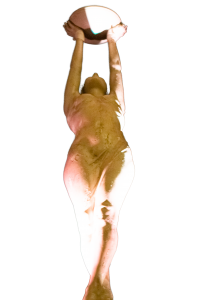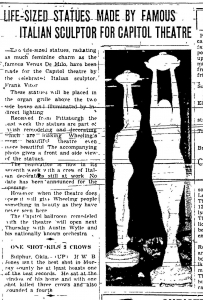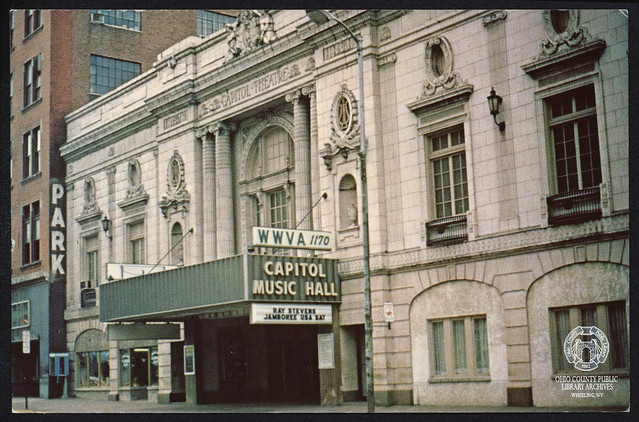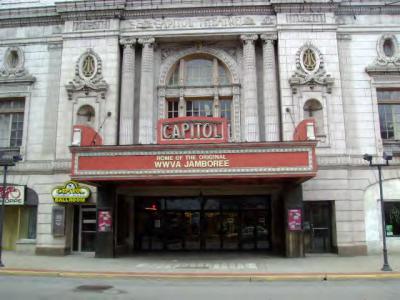The $1,000,000 Capitol Theatre opened on Thanksgiving afternoon, November 29, 1928. The Board of Directors included Lee C. Paull, President; Charles W. Bates, Vice-President and Carl O. Schmidt, Secretary. George Ott was the manager who had been treasurer at the Court and Victoria Theatres.
The exterior of the building had a high retaining wall on the river side. Hundreds of tons of steel were used in the structural frame with concrete and brick built around it. Sheet metal was contained in the walls as an insulation for heat and cold. The foundation was placed to carry eight more stories because an eight-story hotel was planned some 18 months before the construction began. The lobby was to have been on the second floor with an entrance on the north part of the building. The decision was made to not build the hotel after the theatre was completed.
The building was fireproof which included a fireproof roof with a sprinkler on the roof to serve the pipes of the sprinkler system.
There was a copper marquee with a large electric and neon sign at the entrance. A patron's garage connected with a theatre entrance. There were four large bracket lights of solid bronze which cost about $1,000.
The lobby had two box offices. Cylinder type lanterns with prism head lighting fixtures were in the ceiling with pocket lanterns on side walls opposite the ticket booths.
The predominating color scheme for the building was composed of mulberry, delicate green tones, ivory and various shades of golden russet.
The auditorium had two balconies and 3,000 seats with nice soft cushions. It was designed to have unhampered sighting in order that the stage could be viewed from even the remotest corner. The walls of the auditorium were divided into large panels with no carvings but had a narrow border of raised plastering to frame gorgeous silken panels. The proscenium arch which is part of the 44 foot wide stage had beautiful figures. The ceiling lighting fixtures measured 8 feet in diameter and contained hundred of amber color prisms and diffusing bowls. There were two of the same style in the balcony and the boxes had wall pocket lights.
The operator's booth contained three motion picture machines — one for silent films, one for talkies, and a third for an emergency.
Some of the contractors were:
- R.R. Kitchen of Wheeling — General Contractor and supplier of lumber
- Charles W. Bates of Wheeling with office in the Hawley Building, Architect
- Stone & Thomas — selection of hangings in the foyer, mezzanine and the ladies retiring room
- Front Electric of Wheeling — wiring and lighting equipment
- A. Kutch & Sons — tile and marble
- J. E. Moss Iron Works at 28th & Chapline — iron in doors and structural steel
- Adkins Roofing Co. at 86 Zane Street — copper marquee
- H. E. Neumann Co. — heating, plumbing and ventilating
- Greer & Laing — hardware
- Schererlein — sheet metal in walls
- Sam Crowe of Ballaire — painting
- Philip-Carey Co. of Wheeling — fire proof roof
- Strope Sign Co. of Wheeling — electric and neon sign
- J .R. Greelee Co. of Bellaire — glasswork of doors, windows and interior glasswork
- Lee C. Paull Insurance Co. of Wheeling — insurance
- Central Union Trust — all financial arrangements
The doors opened at 12:30 on November 29, 1928. There were four shows with each seat costing sixty cents. At the evening performance, the air was scented with expensive perfumes from the George E. Stifel Co. An estimated 15,000 people attended the shows that day with many standees. The program included stage and screen presentations which included John Steel, tenor; Fantastic Studio, a "melodious futuristic comedy"; Kings of Pantomime, an oddity of comedy and song; a Talkie Film, Romance of the Underworld with Mary Astor, John Boles, Ben Bard and Robert Elliot. Organist Dusty Rhodes played the giant Marr and Colton $50,000 organ from Warsaw, New York. Professor Earl Summers, a resident of Wheeling Island, was selected to conduct the orchestra.
On April 1, 1933, the first Jamboree performance with a live audience was presented to a full house with broadcasting by WWVA which was located in the Hawley Building. The 1935 Wheeling City Directory lists no theatres in the classified section but does list the Ballroom at 1015 Main. After 36 years and nine moves the Jamboree returned to the Capitol in 1969 and the radio station WWVA also moved into the theatre. It was renamed the Capitol Music Hall that year when it was bought by Basic Communications, a firm founded by Emil Mogul, the owner of a successful New York advertising agency.
The Wheeling Symphony Society was also at the Capitol from October 6, 1929 until October 26, 1930 and moved because it was thought moving pictures would detract from total symphony enjoyment. The Wheeling Symphony moved their concerts back to the Capitol on October 5, 1961.
 The Statues
The Statues
 The two familiar female statues were designed by Italian sculptor Frank Vitor and added during a 1936 renovation.
The two familiar female statues were designed by Italian sculptor Frank Vitor and added during a 1936 renovation.










 Want to keep up with all the latest Library news and events?
Want to keep up with all the latest Library news and events? 



